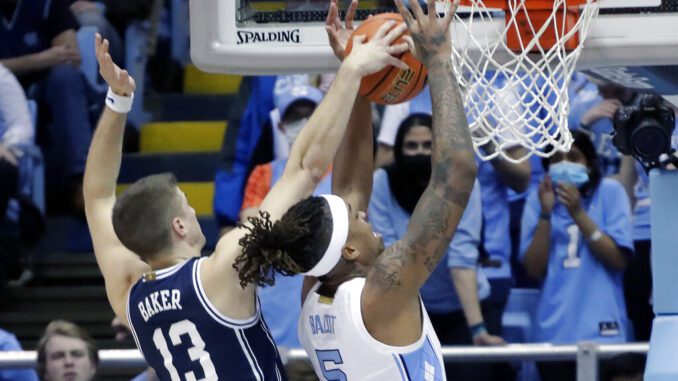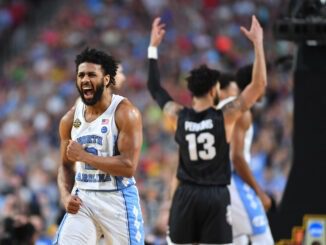
It’s one of the harshest criticisms that can be leveled at a player or a team, but one of the top teams in the Triangle has been dealing with the label all season long. North Carolina has heard all the criticism and read the nasty comments.
“The team is soft.”
“When the Tar Heels get hit in the mouth, they tend to fold instead of getting up and fighting.”
And those are just the things that the players and coaches are saying about themselves.
Other than the word “choke,” there’s not much you could say that’s more damning. And yet, the storyline has been there throughout the season, and the taboo has been broken. What has been whispered online has also been spoken out loud by players and coaches several times this season.
After a nonconference win over UNC Asheville in November, Brady Manek pleaded with his teammates to show more of a killer instinct.
“We’ve got to be up more,” Manek said. “We’ve got to put it on them more, and we’ve got to let them feel how we felt.”
Hubert Davis, in his first season as head coach, also brought up the T-word, saying in early January that he was sick of having to coach “energy, effort and toughness.” After getting blown out by Miami, he said he was, “Very disappointed in our fight, competitiveness, our effort. Just very disappointed.”
The topic came up again following the Tar Heels’ overtime win at Louisville last week when UNC showed some of the fight and competitiveness that Davis has been seeking.
“That was a time where usually, in the past, we would tuck our heads,” said big man Armando Bacot. “But today, we said, ‘Hey, we’ve gotta fight, and we’ve just gotta keep going.’”
“It just shows that we are tough,” Manek said after the game. “Everybody calls us soft. … But tonight we flipped the switch and we hit them back.”
Then came the Duke game, seemingly a major setback in Carolina’s quest to avoid the soft label. The Tar Heels were blown out early and seemed reluctant to challenge the Blue Devils. Eight of their first 12 shots were 3-pointers, many of which missed wildly. Normally one of the best rebounding teams in the ACC, UNC was dominated on the boards by a 40-24 margin. The Tar Heels lost the battle in the paint by 10 points and second-chance points by a 9-2 gap.
Duke was also more physical than the Heels. Bacot was fouled six times in the game, two more than Duke big men Mark Williams, Theo John and Paolo Banchero combined (four times), showing that the Blue Devils were willing to hit their opponents inside to prevent them from scoring. Bacot shot just 4 of 10 in the game, while Williams and John didn’t miss a shot from the field. (Banchero struggled, but that was more due to the defense of Leaky Black than physical play inside.)
So with a month left in the season, UNC is looking to once again prove its toughness and show that it’s hard.
But is it true?
It’s tough to measure toughness or the lack thereof, but we took a look at play in the paint. The Tar Heels have been ripped, particularly in recent games, for missing a large number of layups and for not going “up strong” with the ball, settling for short shots instead of attacking the rim.
According to Bart Torvik’s analytics database, UNC has attempted 68 dunks this season, making 60. They’ve also made 307 of 507 “short” shots — layups and short jumpers in the lane.
That’s a .638 shooting percentage on shots you should make — dunks and layups. That ranks eighth in the ACC — right in the middle. Florida State makes .715 of its close-in shots, Wake Forest .708. Duke, Syracuse, Miami, Virginia Tech and Virginia all shoot better than Carolina.
It’s probably no coincidence that UNC is 6-1 against teams that shoot worse than the Tar Heels on shots they should make and 2-3 against the teams that finish those shots at a better rate.
UNC also only attempts dunks on 11.8% of its close-in shots. Dunk percentage can be used as a proxy measure of a team’s aggressiveness, since many layups or short jumpers could presumably be turned into dunks with another step and a willingness to take contact, at least in the minds of social media critics.
Florida State leads the league with a 19.6% dunk rate on short shots. Duke (18.3) and Wake Forest (14.6) are next. Syracuse and Virginia also have higher dunk rates, with Pitt essentially even with the Tar Heels.
Looking at the top-scoring big men on each team, Bacot, who had a string of more than 10 straight double-doubles, hardly evidence of soft play, ranks seventh in accuracy on close shots at .707. He’s ninth in dunk rate, attacking the rim 18% of the time.
So UNC’s best player and the Tar Heels team as a whole are in the middle of the pack in the ACC. Is that enough to label the team with the nastiest slur in sports? Probably not. But the middle of the pack is also not the place a team that opened the season with tournament hopes wants to be living.



